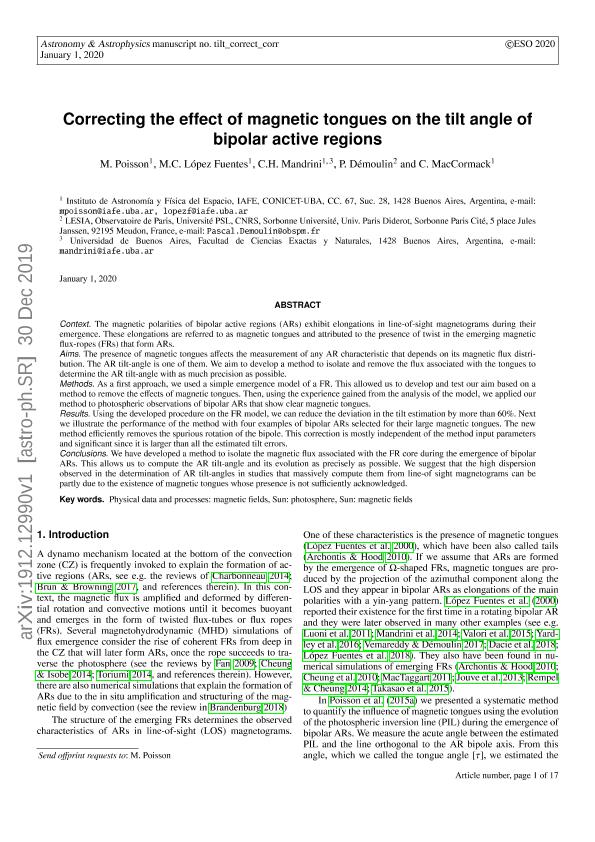Mostrar el registro sencillo del ítem
dc.contributor.author
Poisson, Mariano

dc.contributor.author
López Fuentes, M. C.
dc.contributor.author
Mandrini, Cristina Hemilse

dc.contributor.author
Démoulin, Pascal

dc.contributor.author
MacCormack, C.
dc.date.available
2020-07-30T20:24:12Z
dc.date.issued
2019-12
dc.identifier.citation
Poisson, Mariano; López Fuentes, M. C.; Mandrini, Cristina Hemilse; Démoulin, Pascal; MacCormack, C.; Correcting the effect of magnetic tongues on the tilt angle of bipolar active regions; EDP Sciences; Astronomy and Astrophysics; 633; 12-2019; 1-17
dc.identifier.issn
0004-6361
dc.identifier.uri
http://hdl.handle.net/11336/110608
dc.description.abstract
Context. The magnetic polarities of bipolar active regions (ARs) exhibit elongations in line-of-sight magnetograms during their emergence. These elongations are referred to as magnetic tongues and attributed to the presence of twist in the emerging magnetic flux-ropes (FRs) that form ARs. Aims. The presence of magnetic tongues affects the measurement of any AR characteristic that depends on its magnetic flux distribution. The AR tilt-angle is one of them. We aim to develop a method to isolate and remove the flux associated with the tongues to determine the AR tilt-angle with as much precision as possible. Methods. As a first approach, we used a simple emergence model of a FR. This allowed us to develop and test our aim based on a method to remove the effects of magnetic tongues. Then, using the experience gained from the analysis of the model, we applied our method to photospheric observations of bipolar ARs that show clear magnetic tongues. Results. Using the developed procedure on the FR model, we can reduce the deviation in the tilt estimation by more than 60%. Next we illustrate the performance of the method with four examples of bipolar ARs selected for their large magnetic tongues. The new method efficiently removes the spurious rotation of the bipole. This correction is mostly independent of the method input parameters and significant since it is larger than all the estimated tilt errors. Conclusions. We have developed a method to isolate the magnetic flux associated with the FR core during the emergence of bipolar ARs. This allows us to compute the AR tilt-angle and its evolution as precisely as possible. We suggest that the high dispersion observed in the determination of AR tilt-angles in studies that massively compute them from line-of sight magnetograms can be partly due to the existence of magnetic tongues whose presence is not sufficiently acknowledged.
dc.format
application/pdf
dc.language.iso
eng
dc.publisher
EDP Sciences

dc.rights
info:eu-repo/semantics/openAccess
dc.rights.uri
https://creativecommons.org/licenses/by-nc-sa/2.5/ar/
dc.subject
MAGNETIC FIELDS
dc.subject
SUN: PHOTOSPHERE
dc.subject
SUN: MAGNETIC FIELDS
dc.subject.classification
Astronomía

dc.subject.classification
Ciencias Físicas

dc.subject.classification
CIENCIAS NATURALES Y EXACTAS

dc.title
Correcting the effect of magnetic tongues on the tilt angle of bipolar active regions
dc.type
info:eu-repo/semantics/article
dc.type
info:ar-repo/semantics/artículo
dc.type
info:eu-repo/semantics/publishedVersion
dc.date.updated
2020-05-04T20:50:55Z
dc.journal.volume
633
dc.journal.pagination
1-17
dc.journal.pais
Francia

dc.description.fil
Fil: Poisson, Mariano. Consejo Nacional de Investigaciones Científicas y Técnicas. Oficina de Coordinación Administrativa Ciudad Universitaria. Instituto de Astronomía y Física del Espacio. - Universidad de Buenos Aires. Facultad de Ciencias Exactas y Naturales. Instituto de Astronomía y Física del Espacio; Argentina
dc.description.fil
Fil: López Fuentes, M. C.. Consejo Nacional de Investigaciones Científicas y Técnicas. Oficina de Coordinación Administrativa Ciudad Universitaria. Instituto de Astronomía y Física del Espacio. - Universidad de Buenos Aires. Facultad de Ciencias Exactas y Naturales. Instituto de Astronomía y Física del Espacio; Argentina
dc.description.fil
Fil: Mandrini, Cristina Hemilse. Consejo Nacional de Investigaciones Científicas y Técnicas. Oficina de Coordinación Administrativa Ciudad Universitaria. Instituto de Astronomía y Física del Espacio. - Universidad de Buenos Aires. Facultad de Ciencias Exactas y Naturales. Instituto de Astronomía y Física del Espacio; Argentina
dc.description.fil
Fil: Démoulin, Pascal. Centre National de la Recherche Scientifique. Observatoire de Paris; Francia
dc.description.fil
Fil: MacCormack, C.. Consejo Nacional de Investigaciones Científicas y Técnicas. Oficina de Coordinación Administrativa Ciudad Universitaria. Instituto de Astronomía y Física del Espacio. - Universidad de Buenos Aires. Facultad de Ciencias Exactas y Naturales. Instituto de Astronomía y Física del Espacio; Argentina
dc.journal.title
Astronomy and Astrophysics

dc.relation.alternativeid
info:eu-repo/semantics/altIdentifier/url/https://www.aanda.org/10.1051/0004-6361/201936924
dc.relation.alternativeid
info:eu-repo/semantics/altIdentifier/doi/http://dx.doi.org/10.1051/0004-6361/201936924
dc.relation.alternativeid
info:eu-repo/semantics/altIdentifier/url/https://arxiv.org/abs/1912.12990
Archivos asociados
